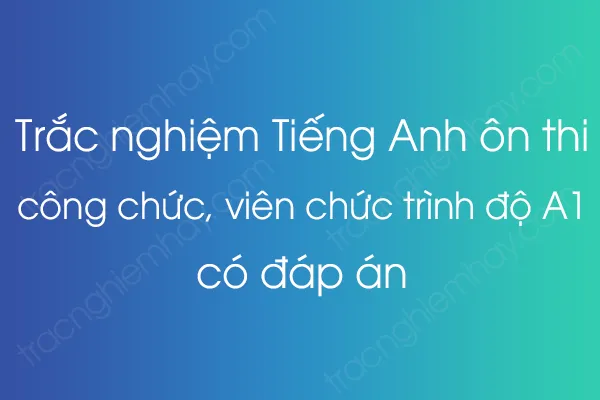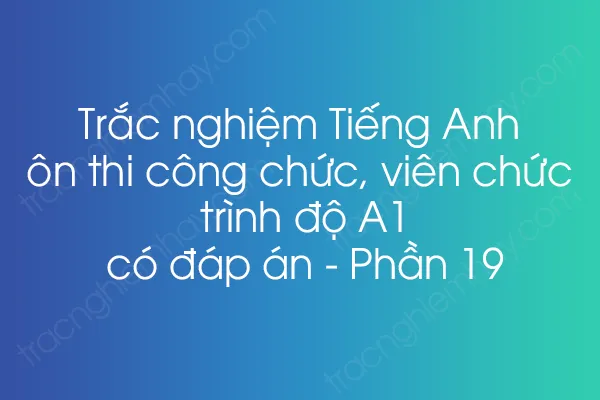
Trắc nghiệm Tiếng Anh ôn thi công chức, viên chức trình độ A1 có đáp án - Phần 12
- 30/08/2021
- 30 Câu hỏi
- 520 Lượt xem
Trắc Nghiệm Hay giới thiệu đến các bạn Trắc nghiệm Tiếng Anh ôn thi công chức, viên chức trình độ A1 có đáp án - Phần 12. Tài liệu bao gồm 30 câu hỏi kèm đáp án thuộc danh mục Trắc nghiệm công chức. Tài liệu này sẽ giúp các bạn ôn tập, củng cố lại kiến thức để chuẩn bị cho các kỳ thi sắp tới. Mời các bạn tham khảo!
Cập nhật ngày
16/10/2021
Thời gian
30 Phút
Tham gia thi
0 Lần thi
Câu 1: A desert is a hostile, potentially deadly environment for unprepared humans. In hot deserts, high temperatures cause rapid loss of water due to sweating, and the absence of water sources with which to replenish it can result in dehydration and death within a few days. In addition, unprotected humans are also at risk from heatstroke. Humans may also have to adapt to sandstorms in some deserts, not just in their adverse effects on respiratory systems and eyes, but also in their potentially harmful effects on equipment such as filters, vehicles and communication equipment. Sandstorms can last for hours, sometimes even days. Despite this, some cultures have made hot deserts 'their home for thousands of years, including the Bedouin, Tuareg tribe, and Pueblo people. Modern technology, including advanced irrigation systems, desalinization and air conditioning, has made deserts much more hospitable. In the United States and Israel for example, desert farming has found extensive use. In cold deserts, hypothermia and frostbite are the chief hazards, as well as dehydration in the absence of a source of heat to melt ice for drinking. Falling through pack-ice or surface ice layers into freezing water is a particular danger requiring emergency action to prevent rapid hypothermia. Starvation is also a hazard; in low temperatures the body requires much more food energy to maintain body heat and to move. As with hot deserts, some people such as the Inuit have adapted to the harsh conditions of cold deserts.
A. troubles that human beings have to face in a desert
B. desert storms and desert inhabitants
C. hot deserts and cold deserts in the United States
D. desert hospitality and environment
Câu 2: Which is not a problem for an unprepared man in a hot desert?
A. Sandstorm
B. Loss of water
C. Irrigation
D. Heatstroke
Câu 3: Sandstorms .
A. do no harm to machinery
B. have effects only on the eyes
C. never lasts more than one hour
D. have bad effects on both human beings and machinery
Câu 4: Which sentence is true?
A. No one can survive in both hot and cold deserts.
B. Modern technology makes deserts more hospitable.
C. In the United States, all deserts are quite uninhabited.
D. There are no deserts in Israel.
Câu 5: Rock Band
A. Complain about her son's friends
B. Give advice to teenagers
C. Describe her son's hobby
D. Compare herself with her parents
Câu 6: Why did the writer give Ben the present he wanted?
A. She wanted to reward him for working hard.
B. He already had too many computer games.
C. She knew he would use it sensibly.
D. He persuaded her it would be a good idea.
Câu 7: Why do the band always practise at Ben's house?
A. It is difficult for Ben to move his drums.
B. The neighbours don't mind the noise.
C. Ben's parents enjoy listening to them.
D. They can leave their equipment there.
Câu 8: What does the writer say about the band members?
A. Their influence on her son worries her.
B. Their taste in music is different from hers.
C. They play their instruments well.
D. They avoid any contact with her.
Câu 9: What might the writer say to her son?
A. Your teacher has just phoned. He wants to know why you weren't at school today.
B. When are you playing at the club next? Dad and I would love to come along again.
C. If you don't know what to do with your self, there's a good programme on the television in a few minutes.
D. Are you sure you've finished your homework? It's more important than band practice.
Câu 10: Craigie Aitchision"
A. Describe particular works by Craigie Aitchison
B. Teach readers how to paint like Craigie Aitchison
C. Introduce readers to the artist Craigie Aitchison
D. Explain how Craigie Aitchison has made money from painting
Câu 11: What can the reader learn about Aitchison from the text?
A. He works in a different way from other artists.
B. He often gets bored with his paintings.
C. He improved his drawing by going to art school.
D. He did some paintings for the Italian government.
Câu 13: Aitchison prefers models who don't…......
A. keep talking to him while he's working
B. ask him about his strange method of working
C. worry about how long the work will take
D. feel anxious to see the work as it's developing
Câu 14: What might a visitor at an exhibition say about Atchison's work?
A. I love his recent paintings of Scotland, which are very similar to a number of other Scottish painters.
B. You can still see the influence of his trip to Italy in some of these pictures.
C. You can tell he spent a lot of time drawing the picture before he started painting.
D. I wonder if his law training helps him at all, especially in the selling his work.
Câu 15: The young achiever of the year
A. Encourage fashion designers to make better business plans
B. Compare a job in fashion with with other choices of career
C. Give details of recent changes in the fashion industry
D. Explain how a woman set up a fashion business
Câu 16: What does the reader learn about Kal's parents?
A. They wanted Kal to help them run the family business.
B. They did not realise that Kal wanted to work in fashion.
C. They insisted Kal should continue with her job in advertising.
D. They did not think Kal worked hard enough at university.
Câu 17: Kal decided to borrow £20,000 when……
A. all her clothes in the London shop were sold.
B. her friends asked her to make clothes for them.
C. she lost her job at the advertising agency.
D. the fashion industry was in a period of growth.
Câu 18: What does Kal say about her career?
A. She plans to open more stores.
B. She believes that she deserves her success.
C. She particularly enjoys designing for famous people.
D. She expects more people to buy her clothes after the award.
Câu 19: What might Kal say now about her career?
A. My management degree has helped me more than anything else. It's so important that young people interested in fashion can deal with money.
B. I've learnt so much working for other fashion designers. Without this experience, I couldn't have started my own business.
C. Running a fashion business is a dream come true and my parents being happy with my choice are even more special.
D. Even when I was at university, my friends liked the clothes I made. This encouraged me to think about a career in fashion
Câu 20: I _________ my English a lot since the last seminar.
A. improved
B. improve
C. have improved
D. has improved
Câu 23: When do many people drink coffee?
A. During breaks
B. At lunch
C. On their way to work
D. All of them are correct.
Câu 24: Not drinking enough water is a problem for ________.
A. coffee drinkers
B. doctors
C. officers
D. workers
Câu 25: How much water should people drink every day?
A. Less than four glasses
B. Eight or more glasses
C. One glass for every cup of coffee
D. No more than two glasses
Câu 27: The teacher told Jessey ____________.
A. stop talking
B. to stop talking
C. stops talking
D. stopped talking
Câu 28: Jack asked me __________interested in football.
A. when had you born
B. when I was born
C. when were you born
D. when I had been born
Câu 30: I wonder __________.
A. where he has gone
B. has he gone where
C. where has he gone
D. he has gone where

Chủ đề: Trắc nghiệm Tiếng Anh ôn thi công chức, viên chức trình độ A1 có đáp án Xem thêm...
- 0 Lượt thi
- 30 Phút
- 30 Câu hỏi
- Người đi làm




Chia sẻ:
Đăng Nhập để viết bình luận